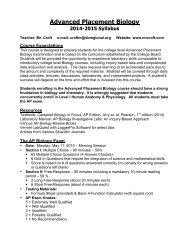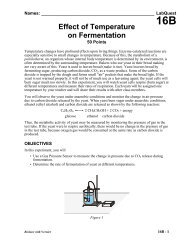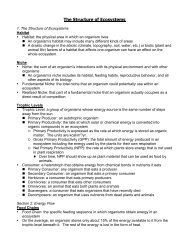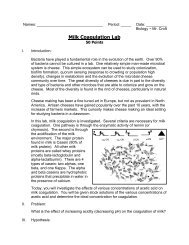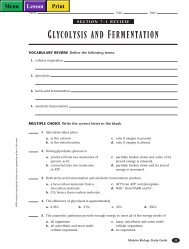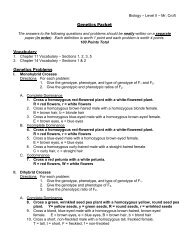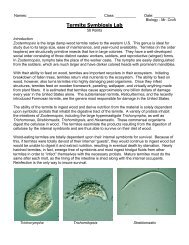Principles of Diffusion and Osmosis - Mr. Croft's
Principles of Diffusion and Osmosis - Mr. Croft's
Principles of Diffusion and Osmosis - Mr. Croft's
- No tags were found...
Create successful ePaper yourself
Turn your PDF publications into a flip-book with our unique Google optimized e-Paper software.
<strong>Principles</strong> <strong>of</strong> <strong>Diffusion</strong> <strong>and</strong> <strong>Osmosis</strong>40 PointsBiology<strong>Mr</strong>. Cr<strong>of</strong>tAnswer all questions on a separate sheet <strong>of</strong> paper.Activity One - Learning about <strong>Osmosis</strong> <strong>and</strong> Dialysis MembranesProcedure:1. Prepare two pieces <strong>of</strong> dialysis tubing as follows:• Roll the dialysis bag between your thumb <strong>and</strong> pointer finger under tap water to openthe bag.• Fold over approximately 1 inch <strong>of</strong> the end <strong>of</strong> the dialysis tubing.• Carefully tie a knot 1/2 inch from the end <strong>of</strong> the dialysis tubing.• Be sure to keep the tubing moist by rinsing with tap water as needed.2. Prepare two water baths as follows:• Fill two cups with 200 mL <strong>of</strong> distilled water.3. Fill the first dialysis bag with violet dye:• Roll the untied end <strong>of</strong> the dialysis bag between your thumb <strong>and</strong> pointer finger toreopen the end <strong>of</strong> the bag.• Squeeze the transfer pipet bulb <strong>and</strong> fill it with dye up to a level just below the pipetbulb.• Gently insert tip <strong>of</strong> the transfer pipet deep into the bag.• Apply pressure on the bulb to transfer the contents <strong>of</strong> the pipet to the dialysis bag.• Carefully tie a knot at the open end <strong>of</strong> the bag using the technique in Step 1.4. Place the dialysis bag in one <strong>of</strong> the water baths.5. Fill the second dialysis bag with orange dye. Follow the same procedures as outlined inSteps 3&4. You should now have two filled dialysis bags (one violet, <strong>and</strong> one orange) ina beaker <strong>of</strong> water.5. Wait 15 minutes (work on Activity 2 while you are waiting).6. One at a time, remove each bag filled with dye <strong>and</strong> place it on a piece <strong>of</strong> wax paper.Questions (3 Points Each):1. Record your observations for each dialysis bag.2. Is there any change in the color <strong>of</strong> the liquid in the bags? in the water?3. Which <strong>of</strong> the two dyes has a smaller molecular size? Why? Which has a largermolecular size? Why?Activity Two - Effect <strong>of</strong> Salt on <strong>Osmosis</strong>Procedure:1. Prepare a fresh dialysis bath as described in Activity One.2. Add 5 Teaspoons <strong>of</strong> salt to the dialysis bath. Stir until the salt is dissolved.3. From Activity One, obtain dialysis bag that still contains dye.Hint: This is the high molecular weight dye, <strong>and</strong> it did not pass through the dialysismembrane.4. Place the dialysis bag saved from Activity One into the dialysis bath that now containssalt.5. After 24 hours, observe if there is any change in the dialysis bag.
6. Periodically check to see if any changes in color or volume has occurred.Questions (3 Points Each):7. Has the color changed?8. Does the volume <strong>of</strong> the bag appear the same or different?9. Analyze the contents <strong>of</strong> the bag.Review Questions (7 Points Each):10. What molecular weight cut <strong>of</strong>f value would allow both dyes from Activity One to penetratethe membrane?11. How could the rate <strong>of</strong> dialysis <strong>of</strong> the orange dye from Activity One be increased?12. A protein having a molecular weight <strong>of</strong> 65,000 has been purified. The protein solutionhas a high concentration <strong>of</strong> sodium chloride as a result <strong>of</strong> the last purification step.Suggest a method for removing the salt from the protein solution.Information about the dialysis tubing <strong>and</strong> dyes:Dialysis membranes are made <strong>of</strong> purified cellulose containing microscopic pores.The pore size is controlled during manufacturing. The pore size determines themembrane’s permeability to solutes <strong>of</strong> different sizes. Increasing size generallycorresponds to increasing molecular weight when the molecules have similarshapes. The dialysis tubing being used in this experiment has a molecular cut <strong>of</strong>f <strong>of</strong>approximately 10,000. The orange dye has a molecular weight <strong>of</strong> about 300 <strong>and</strong> theviolet dye has a molecular weight in excess <strong>of</strong> 100,000.




